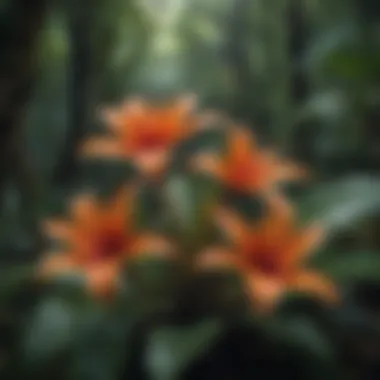Exploring Brazil's Unique Flora: Diversity and Conservation


Intro
Brazil is home to one of the most diverse collections of plant life found on the planet. This diversity is not only remarkable but also critical for maintaining the balance of global ecosystems. The interaction between different species and their environments in Brazil creates a unique tapestry of ecological relationships that is essential for numerous life forms, including humans. Understanding this complexity can enhance our appreciation for nature and the importance of conservation efforts.
The Brazilian landscape varies significantly, from the Amazon rainforest to the Atlantic Forest and the cerrado, each supporting its own distinct flora. Yet, the risks posed by human activities, such as deforestation and climate change, have prompted urgent discussions about conservation strategies and practices. Through this exploration of Brazil's flora, we will cover key findings related to biodiversity, the ecological roles of various species, and the pressing threats they face.
Research Highlights
Key Findings
Brazil's flora consists of an estimated 55,000 species of vascular plants, a significant portion of which are endemic, meaning they are found nowhere else in the world. Several economically important species contribute vastly to both local and global economies. For instance:
- Cacao (Theobroma cacao) is critical in the chocolate industry.
- Brazil nut (Bertholletia excelsa) is not only a source of nutrition but also supports local economies.
The Brazilian rainforest plays an essential role in regulating the Earth's climate. The extensive plant life absorbs carbon dioxide, helping to mitigate climate change.
Implications and Applications
The survival of Brazil's flora has implications beyond the borders of the country. The loss of species can disrupt global ecosystems. Conservation efforts such as reforestation, habitat preservation, and sustainable land use are crucial to ensure the continuity of these invaluable resources. Furthermore, protection of endemic species can help maintain genetic diversity, vital for future food security and medical discoveries.
Methodology Overview
Research Design
This article synthesizes existing research studies, government reports, and conservation programs focusing on Brazil's flora. Data were collected from scholarly articles, environmental organizations, and interviews with conservationists. This multi-faceted approach allows for a comprehensive view of both the current state and the efforts undertaken to preserve Brazil’s botanical diversity.
Experimental Procedures
Field studies conducted by various institutions help document species diversity and distribution. For example, researchers survey specific regions like the Amazon basin to catalog flora. Mapping software is then used to analyze spatial patterns in plant species and identify areas of highest conservation value.
"The preservation of Brazil's unique biodiversity is not just the responsibility of the local populations, but a global imperative."
Finale
The complex interplay of Brazil’s diverse ecosystems fosters an abundance of plant life that is invaluable not only to the nation but to the entire planet. Understanding this biodiversity and the threats it faces can lead to more effective conservation strategies. This exploration of Brazilian flora highlights the significance of safeguarding these ecosystems, reinforcing the essential role they play in global health and sustainability.
Foreword to Brazilian Flora
The flora of Brazil represents one of the most diverse and rich plant systems on Earth. Brazil's distinct ecosystems provide unique habitats that foster a wide variety of plant species. This introduction covers the importance of understanding Brazilian flora in relation to global biodiversity and conservation efforts. Additionally, it highlights the interconnectedness between flora and ecosystems that is fundamental for ecological studies.
Overview of Brazil's Plant Diversity
Brazil is home to around 55,000 distinct plant species, which is about 22% of all plant species on the planet. This diversification arises from a combination of factors, including the country's vast area, varied climates, and diverse geographies ranging from tropical rainforests to savannas and wetlands. The Amazon Rainforest is pivotal as it contains approximately 40% of Brazil’s plant species, many of which remain unnamed.
The country's flora not only supports local ecosystems; it also plays a critical role in global ecological balance. Plants contribute to carbon sequestration, oxygen production, and provide habitats for an array of wildlife.
Significance of Brazilian Plants
The significance of Brazilian plants extends beyond biodiversity. They are vital for many economic activities, including agriculture, medicine, and ecotourism. Numerous plant species have commercial value, such as açai berries and rubber trees, which impact local economies significantly.
Additionally, certain plants hold cultural importance for indigenous communities, serving as sources of food, medicine, and materials for crafts. There is also a growing interest in sustainable practices and conservation efforts aimed at preserving these plant species in their natural environments.
"Biodiversity is the cornerstone of the resilience of ecosystems and the services they provide to humanity."


Understanding the richness of Brazil's plant life and its significance offers insight into the need for conservation initiatives. As human activities continue to threaten these important ecosystems, preserving Brazilian flora becomes increasingly crucial for future generations.
Key Ecosystems Supporting Brazilian Flora
Brazil is home to some of the world’s most biologically diverse ecosystems. Each ecosystem is unique, providing essential habitats for a multitude of plant species. Understanding these ecosystems is crucial for comprehending the broader narrative of Brazilian flora. The interaction between climate, geography, and human activity shapes these environments. As such, conservation efforts must take these factors into account. Their preservation is vital not only for biodiversity but also for cultural, economic, and ecological reasons.
The Amazon Rainforest
The Amazon Rainforest is one of the most significant ecosystems in Brazil and indeed the world. It spans multiple countries but contains a large portion within Brazilian territory. This rainforest is renowned for its extensive biodiversity. It hosts approximately 40,000 plant species, including towering trees, creeping vines, and colorful flowers. The sheer volume of flora not only provides habitats for wildlife but also contributes to global oxygen supply and carbon storage.
Factors like high rainfall and warm temperatures contribute to the growth of many plant species. Dense canopies create a multilayered environment. These conditions encourage rich adaptations among flora. Many plants here have medicinal properties, making them valuable beyond ecological aspects.
However, the Amazon faces threats such as deforestation for agriculture and logging. These activities disrupt the delicate balance of the ecosystem, putting at risk countless plant species that are yet to be discovered. Maintaining the integrity of the Amazon is not just vital for Brazil, but for global health.
The Atlantic Forest
The Atlantic Forest, stretching along the Brazilian coast, is another important ecosystem. Despite its beauty, it is highly fragile and has been extensively altered by human activity. Originally home to over 20,000 plant species, only a fraction remains today due to urbanization and agriculture.
This forest is characterized by a mix of trees, ferns, and orchids. A notable feature is its high level of endemism. Many plants found here cannot be found anywhere else on the planet. Their loss would mean extinction of irreplaceable species. Moreover, the Atlantic Forest plays a key role in supporting numerous wildlife species.
Conservation programs focus on restoring degraded areas and protecting remaining fragments. Efforts include creating protected areas and implementing sustainable practices. Only with ongoing commitment can we hope to sustain its remarkable biodiversity.
The Cerrado Savanna
The Cerrado Savanna is a distinct ecosystem famous for its diverse vegetation. This ecosystem includes grasslands, woodlands, and scrub, hosting approximately 12,000 vascular plant species. The unique climate, with a wet and dry season, shapes the flora here. Many plants have adapted to survive drought conditions by developing deep root systems.
The Cerrado also plays a critical role in watershed protection. It feeds into major rivers, ensuring clean water sources for millions. Despite its ecological importance, this savanna is threatened by agricultural expansion and over-grazing. Maintaining this ecosystem is crucial for Brazil's food security. A focused approach to sustainable land use can help protect its unique flora.
The Pantanal Wetlands
The Pantanal Wetlands stand as one of the largest tropical wetland areas globally. Rich in biodiversity, it supports over 3,500 plant species. Flooding during the rainy season results in a unique ecosystem set teeming with life. Many species rely on the fluctuating water levels for reproduction and growth.
Plants in this region such as grasses, aquatic plants, and trees play a vital role in maintaining ecological balance. They provide habitat for numerous birds, fish, and mammals. The Pantanal is not only crucial for the plants and animal inhabitants but also has significance for local communities that depend on its resources for livelihood.
However, the Pantanal faces issues from agricultural runoff and climate change. Ensuring proper management practices and conservation measures will protect this vital ecosystem.
The key ecosystems in Brazil support an astounding array of plant diversity, each playing a unique role in maintaining ecological balance and supporting human life.
As we look upon these ecosystems, we understand that they are interconnected. The health of one impacts the others. Their importance cannot be overstated in the narrative of Brazilian flora. Preservation efforts must take a holistic approach, encompassing conservation and sustainable practices for future generations.
Endemic and Iconic Plant Species
Understanding endemic and iconic plant species is crucial in appreciating the unique biodiversity found in Brazil. These plants not only thrive in specific ecological niches but also reflect the rich evolutionary history of the region. The existence of endemic species highlights the significance of preserving Brazil's diverse habitats, as many of these plants are adapted to local environmental conditions and may not survive outside their native ranges.
Unique Flora of the Amazon
The Amazon rainforest is home to a remarkable array of unique flora. Many species here are endemic, meaning they are found nowhere else in the world. For instance, the Victoria amazonica, known for its large, floating leaves, is a lily species that thrives in the Amazon's slow-moving waters. Another example is the Bertholletia excelsa, commonly known as the Brazil nut tree. This species is critical not only to the ecosystem but also to local economies, as its nuts are commercially harvested.
The diversity of the Amazon flora contributes to overall ecological health. By providing habitats for countless species, these plants play essential roles in nutrient cycling, carbon storage, and maintaining the water cycle. The endemic nature of the flora in the Amazon makes conservation efforts imperative to ensure their survival alongside various threats.
Threatened Species in Brazil
Brazil’s plant life faces numerous threats, and many endemic species are at risk. Habitat destruction from deforestation and land-use change is the leading cause of these plants becoming endangered. For example, the Caryocar brasiliense, also known as the pequi tree, is vital to both biodiversity and local cultures, but it is now threatened by agricultural expansion.


According to experts, nearly one in four species in Brazil is now at risk of extinction. This statistic serves as a stark reminder that protection efforts must be intensified. Conservationists are working diligently to establish protected areas and enforce regulations, yet the challenges remain formidable.
Cultural Significance of Certain Plants
Many plants native to Brazil hold significant cultural importance. For example, the Pau Brasil tree, from which the country gets its name, is not only symbolic but also integral to traditional crafts and music. Various indigenous groups use local flora for medicinal purposes, showcasing the deep connection between plants and cultural practices.
Moreover, plants like Ipê trees are celebrated during festivals for their stunning flowers and play a role in local architecture through their resilient wood. This cultural significance emphasizes the need for conservation, as losing these plants would mean losing not just biodiversity but also cultural heritage.
"The uniqueness of Brazil's plant species reflects the interwoven fabric of ecological balance and cultural identity. Protecting these plants is essential for preserving both nature and tradition."
In summary, endemic and iconic plant species tell a complex story of Brazil's ecological identity. Their uniqueness and cultural ties represent valuable assets that contribute to global biodiversity. Understanding these aspects is critical for informed conservation efforts.
Ecological Roles of Brazilian Plants
The ecological roles of Brazilian plants are pivotal in maintaining the health and balance of various ecosystems. Given Brazil’s wide range of ecosystems, from the Amazon rainforest to the Pantanal wetlands, the roles plants play are numerous and complex. These roles include providing habitat for countless species, stabilizing soil, and regulating water cycles. Such functions are not merely beneficial; they are essential for the sustainability of the environment and ultimately for human well-being.
Plants and Biodiversity
Plants are fundamental to the biodiversity found in Brazil. They serve as the primary producers in an ecosystem, forming the base of the food chain. The Amazon rainforest, for instance, houses about 40,000 plant species, each contributing to the overall biodiversity. This diversity leads to more resilience in ecosystems, allowing them to adapt to changes and disturbances. Plants also interact with a variety of organisms; for example, they provide food and shelter for animals, insects, and fungi that depend on them for survival. Furthermore, many plant species have co-evolved with other organisms, ensuring a balance that supports ecosystem integrity.
Research indicates that a diverse plant community enhances ecosystem productivity and stability. A study published on en.wikipedia.org highlights how specific plants can improve the nutrient cycling of the soil, which is crucial for all living organisms. Here are some key aspects of plant contributions to biodiversity:
- Habitat Creation: Different plant species create diverse habitats that support various forms of life.
- Inter-species Relationships: They engage in mutual relationships with animals for pollination and seed dispersal.
- Genetic Diversity: A variety of plants ensures genetic variation, which is vital for ecological adaptability.
Ecosystem Services Provided by Flora
Brazilian flora provides a broad range of ecosystem services that are often underestimated. These services are natural processes that benefit humanity and the environment. Some significant ecosystem services include:
- Carbon Sequestration: Plants absorb carbon dioxide from the atmosphere, helping to mitigate climate change.
- Soil Stabilization: The root systems of plants prevent soil erosion, which is critical in protecting land and water quality.
- Water Regulation: Flora influences the hydrological cycle, controlling water flow and maintaining groundwater levels.
- Pollination: Many crops depend on native plants for pollination, essential for food production.
"The ecological balance provided by Brazilian flora is a cornerstone in the global climate system and agricultural processes."
Threats to Brazilian Flora
The biodiversity of flora in Brazil is under significant threat. Understanding these threats is crucial to the broader conversation about conservation and the health of ecosystems around the world. Deforestation, climate change, and invasive species serve as the main challenges to Brazil’s diverse plant life. Each threat not only impacts the individual species but also the overall integrity of ecosystems, their services, and human wellbeing.
Deforestation and Land Use Change
Deforestation in Brazil is alarming. The Amazon rainforest, often called the lungs of the planet, has been significantly affected. Land is cleared for agriculture, logging, and infrastructure. This leads to loss of habitat, endangering both endemic and economically vital plant species. In many cases, deforested areas never fully recover, which severely affects local biodiversity.
- Impact on Species: Many plants are adapted to specific environments. When these environments are destroyed, species can become threatened or extinct.
- Soil Degradation: The removal of trees leads to increased erosion and soil degradation. This not only hampers plant growth but also affects overall ecosystem health.
- Fragmentation: As forests are cut down, the remaining patches become isolated. This fragmentation disrupts animal movements and plant reproduction, making it harder for many species to thrive.
Ultimately, the loss of forests alters entire ecosystems and threatens the benefits these areas provide, from carbon storage to water purification.
Climate Change Impacts
Climate change poses another serious threat to Brazilian flora. As temperatures rise and weather patterns shift, many native plants find it difficult to adapt. Changes in rainfall patterns and increased frequency of extreme weather events such as droughts and floods can disrupt growth cycles.
- Shifts in Habitat: Many species may be forced to migrate to cooler areas. However, with urban development and agricultural expansion, this option diminishes.
- Phenological Changes: Altered blooming and fruiting times can lead to mismatching with pollinators. This disruption can have long-lasting effects on reproductive success.
- Increased Vulnerability: Many plant species are now more susceptible to pathogens and pests. Warmer temperatures can support the proliferation of harmful organisms.
Invasive Species Problems
Invasive species are another critical issue threatening Brazilian flora. Non-native plants can outcompete indigenous species for resources such as sunlight, space, and nutrients. This often leads to the decline or extinction of native flora.


- Altered Ecosystems: Invasive plants can change the structure and dynamics of ecosystems, setting off a chain reaction that affects both animal and plant populations.
- Economic Costs: Management of invasive species can be costly for local communities and governments. The funds spent on controlling these species could often be used for more beneficial conservation efforts.
- Loss of Unique Species: Iconic plant species in Brazil can become at risk due to invasive competition. They often struggle to coexist with intruding flora.
The health of Brazil's flora is a barometer for ecological resilience. Understanding these threats helps to prioritize conservation efforts effectively.
Conservation Efforts and Initiatives
Conservation efforts in Brazil are crucial for maintaining its extensive biodiversity. Brazilian flora is home to thousands of species that are unique and essential to ecological stability. Initiatives in this area focus on protecting these plants and their habitats while also addressing the broader challenges of biodiversity loss. The conservation strategies not only help safeguard the botanical richness but also enhance local economies, promote sustainable use of resources, and support ecological research. By investing in the protection of plant species, Brazil contributes to global efforts in combating climate change and preserving ecological balance.
Protected Areas and National Parks
Brazil has a wealth of protected areas and national parks dedicated to preserving its unique flora. These areas play a significant role in maintaining biodiversity and serve as refuges for endangered species. The parks include iconic reserves like the Tijuca National Park in Rio de Janeiro and the Chapada dos Veadeiros National Park in Goiás. These parks provide habitats that are shielded from urban development and deforestation, allowing native plants to thrive.
Protected areas are often established based on ecological criteria, which consider the habitat needs of various species. This planning can mitigate threats from invasive species and habitat destruction. Additionally, parks promote eco-tourism, offering educational experiences for visitors while generating revenue that supports local communities and ongoing conservation efforts.
Community Involvement in Conservation
An essential aspect of successful conservation in Brazil involves the active participation of local communities. Engaging indigenous populations and local residents is key to sharing knowledge about the land and its flora. Many communities rely on plants for their livelihoods, and their traditional practices often promote sustainable use of these resources.
Community-led initiatives can include reforestation projects, educational workshops about native plant care, and the establishment of community gardens. These projects foster a sense of ownership and pride among residents, ensuring that conservation efforts are lasting and culturally relevant. For instance, programs that teach sustainable harvesting techniques not only protect the ecosystem but also enhance the livelihoods of local families.
International Collaboration in Biodiversity Conservation
Brazil’s biodiversity is a global concern, making international collaboration vital. Numerous countries and organizations work together on conservation projects aimed at protecting the Amazon rainforest and other critical ecosystems. Global partnerships facilitate the transfer of knowledge and resources, enhancing the effectiveness of conservation initiatives.
Collaborative efforts often involve research programs focused on understanding plant species and their responses to environmental changes. For example, initiatives running under the Convention on Biological Diversity connect nations to share research findings and develop conservation strategies collaboratively. Such alliances help in pooling funding for significant projects and in advocating for policies that protect biodiversity on an international scale.
"Through collaborating with international partners, Brazil enhances its capacity to protect biodiversity effectively while sharing its unique ecological knowledge with the world."
In summary, conservation efforts and initiatives in Brazil encompass protective measures, community engagement, and global partnerships. They are vital for preserving flora diversity and combating environmental challenges. Understanding the intricate connections among plant species, human societies, and ecosystems remains crucial in these ongoing efforts.
Future Directions in Plant Research
Understanding the future directions in plant research is essential for maintaining the biodiversity of Brazil's unique flora. As the landscape of environmental science evolves, several key areas indicate where research is heading. These advancements can significantly contribute to the preservation and sustainable management of plant species. The ongoing integration of innovative technologies and methodologies can refine our approach to biodiversity conservation, which is increasingly critical in the context of global environmental change.
Biotechnological Advances
Biotechnological advances play a pivotal role in plant research. Tools such as genetic modification and CRISPR technology allow scientists to develop plant varieties that are more resilient to climate fluctuations and diseases. These techniques can enhance yield and reduce the need for chemical fertilizers or pesticides, which can be detrimental to the environment.
Moreover, molecular markers are useful in the conservation of specific plant species. They help researchers monitor genetic diversity and the health of various plant populations. This is particularly important for endemic species that have limited distribution and are at high risk of extinction. Collaborative projects that integrate biotechnology with traditional conservation practices show great promise for ensuring the survival of these species in the face of imminent threats.
"Biotechnology has the potential not just to revolutionize agriculture, but also to protect biodiversity and our ecological heritage."
Restoration Ecology
Restoration ecology is another vital area in plant research. It focuses on the recovery of degraded ecosystems, aiming to bring back natural habitats and the biodiversity they support. Brazil offers various ecosystems that have suffered from human activities, particularly deforestation and urbanization.
Research in restoration ecology involves understanding the original conditions of degraded sites and how to best reinstate them. This includes selecting suitable native species for replanting, monitoring plant growth and diversity, and evaluating the impacts of restoration efforts on local wildlife.
Organizations are now recognizing the importance of restoring native flora as a broader strategy for ecosystem recovery. Community involvement is essential in these projects, from seed collection to planting and long-term monitoring. Education plays a critical role here, fostering a sense of stewardship among local populations. In summary, biotechnological innovations and restoration ecology efforts are promising avenues for enhancing the resilience and sustainability of Brazilian flora amid growing environmental challenges.
Epilogue
The conclusion serves as a synthesis of the vast topics discussed in the article regarding Brazil's flora. It brings together the various elements that show the complexity and richness of plant biodiversity found within this country. Understanding these elements is crucial not only for preserving this diversity but also for appreciating the ecological and cultural significance they offer.
Summation of Key Insights
The exploration of Brazil's diverse plant life reveals important insights into ecosystem dynamics and conservation challenges. Some key points include:
- Plant Diversity: Brazil is home to approximately 55,000 species of vascular plants, making it one of the most biodiverse countries in the world.
- Endemism: Many plants found in Brazil are endemic, meaning they cannot be found anywhere else globally. These species play a crucial role in their respective ecosystems.
- Ecosystem Services: Flora in Brazil supports various ecosystem services, including carbon sequestration, soil stabilization, and habitat provision for numerous animal species.
- Threats: The threats posed by deforestation, climate change, and invasive species highlight a pressing need for effective conservation strategies.
- Conservation Efforts: Various initiatives, such as the creation of protected areas and community involvement in conservation practice, demonstrate ongoing efforts to preserve the flora.
"The conservation of Brazil's floral diversity is not just about saving plants; it impacts the survival of entire ecosystems and the human culture intertwined with them."



